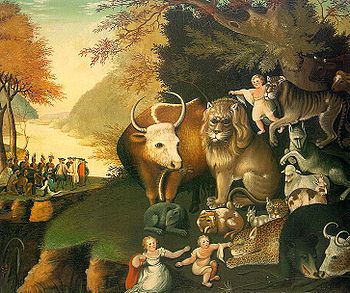
Bob Denham writes, in response to “Frye on Lincoln“:
We might also call attention to Frye’s concluding paragraph to the Whidden Lectures, delivered at McMaster University on the occasion of the centenary of Confederation:
I referred earlier to Grove’s A Search for America, where the narrator keeps looking for the genuine America buried underneath the America of hustling capitalism which occupies the same place. This buried America is an ideal that emerges in Thoreau, Whitman, and the personality of Lincoln. All nations have such a buried or uncreated ideal, the lost world of the lamb and the child, and no nation has been more preoccupied with it than Canada. The painting of Tom Thomson and Emily Carr, and later of Riopelle and Borduas, is an exploring, probing painting, tearing apart the physical world to see what lies beyond or through it. Canadian literature even at its most articulate, in the poetry of Pratt, with its sense of the corruption at the heart of achievement, or of Nelligan with its sense of unfulfilled clarity, a reach exceeding the grasp, or in the puzzled and indignant novels of Grove, seems constantly to be trying to understand something that eludes it, frustrated by a sense that there is something to be found that has not been found, something to be heard that the world is too noisy to let us hear. One of the derivations proposed for the word “Canada” is a Portuguese phrase meaning “nobody here.” The etymology of the word “Utopia” is very similar, and perhaps the real Canada is an ideal with nobody in it. The Canada to which we really do owe loyalty is the Canada that we have failed to create. In a year bound to be full of discussions of our identity, I should like to suggest that our identity, like the real identity of all nations, is the one that we have failed to achieve. It is expressed in our culture, but not attained in our life, just as Blake’s new Jerusalem to be built in England’s green and pleasant land is no less a genuine ideal for not having been built there. What there is left of the Canadian nation may well be destroyed by the kind of sectarian bickering which is so much more interesting to many people than genuine human life. But, as we enter a second century contemplating a world where power and success express themselves so much in stentorian lying, hypnotized leadership, and panic-stricken suppression of freedom and criticism, the uncreated identity of Canada may be after all not so bad a heritage to take with us. (The Modern Century)
To which Joe replies:
Yes, thanks for this, Bob. And even more powerful perhaps in its evocation of the pastoral myth and its relation to both America’s and Canada’s “buried or uncreated ideal, the lost world of the lamb and the child,” is the passage from the Conclusion to the Literary History of Canada, where he speaks of Edward Hick’s great painting of The Peacable Kingdom [shown above].
Here, in the background, is a treaty between the Indians the the Quaker settlers under Penn. In the foreground is a group of animals, lions, tigers, bears, oxen, illustrating the rophecy of Isaiah about the recovery of innocence in nature [11:6-9]. Like the animals of the Douanier Rousseau, they stare past us with a serenity that transcends conscousness. It is a pictorial emblem of what Grove’s narrator was trying to find under the surface of America: the reconciliation of man with man and of man with nature: the mood of Thoreau’s Walden retreat. of Emily Dickinson’s garden, of Huckleberry Finn’s raft, of the elegies of Whitman. . . . This mood is closer to the haunting vision of a serenity that is both human and natural which we have been struggling to identify in the Canadian tradition. It we had to characterize a distinctive emphasis in that tradition, we might call it a quest fo the peacable kingdom (CW 12: 371)

To go along with Edward Hick’s painting is the painting on the cover of the reading series *Literature: Uses of the Imagination* put together by Alvin and Hope Lee, using Frye’s theory. The unit *The Peaceable Kingdom* has Vincent Van Gogh’s The Sower.